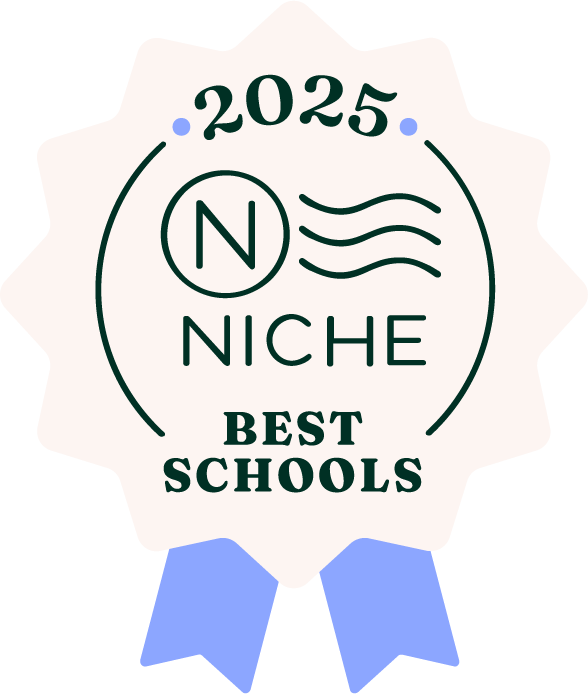The Montessori method is a research-based educational approach that stresses cooperative learning with an integrated and interdisciplinary curriculum. Contrary to the “factory-model” found in many school systems today (students move grade-by-grade through a standardized curriculum like a product through a factory), Montessori schools educate through multiage learning communities based on the natural development of each individual child. They teach in carefully prepared environments created to look more like a home than an institution, and stress a community-based approach to learning.
Modern educational research supports the premise that children learn better working collaboratively than working alone. Just as adults work together in local communities and businesses, students in Montessori classrooms discuss and collaborate with colleagues of their own choosing. These periods of discussion, the meeting of minds and sharing of ideas, is fundamental to the production of highly effective and creative academic learning.
Students remain in their multiage Montessori classrooms for three years. This approach results in deeper friendships and student-teacher partnerships which span a longer time period than conventional single-age groupings. Students are motivated to learn through collaboration with friends. The familiar peer groupings reinforce the positive results of academic achievement which further propels the child to higher levels of performance. By placing the learning process in a context of highly desired social interaction, Montessori schools best meet the developmental needs of children while fostering and inherent love for learning independent of external motivators like testing and grades.
In conventional schools knowledge is defined in learning objectives that allows the use of pre-set methods and materials. These may be realized in a syllabus, a textbook, curriculum guides, or increasingly, online learning modules
Response modes for the students are limited, defined by structured classroom discussion, specific assignments, and tests based on content and not discovery
Learning activities are divorced from ordinary experience, fragmented into short blocks of time, and framed within narrowly-defined disciplines. Pace of instruction is usually set by group norm or teacher
The breadth and depth of information that is accessible in a globalized, technological society no longer makes content relevant
Learning takes place by an original and personal process of discovery. Each child’s natural learning styles and preferences are respected and supported
Child is able to choose his or her own work, direct their own progress, set own learning pace to internalize information, and seek help from other children and adults when they need it
Students are driving more of the decisions in how learning takes place. There are varied pathways to instructional goals. These new routes are intended to be more efficient and avoid barriers to success
Our best teachers try to anticipate learners’ preferences and needs, watch the varied learning that is taking place, and measure success towards learning goals in innovative ways. They adjust their subsequent learning designs based on new insights on the interaction of their learners with the more flexible design of learning.
Teacher has dominant, active role in classroom activity; child is a passive participant in learning
Instruction, both individual and group, conforms to the adult’s teaching style
Teacher acts as primary enforcer of external discipline
Teacher has unobtrusive role in classroom activity; child is an active participant in learning
Instruction, both individual and group, personalized to each student’s learning style.
Environment and method encourage internal self-discipline
Most teaching is done by teacher and collaboration is discouraged
Child is guided to concepts by teacher with structured curriculum
Emphasis on the individual devalues contribution and collective responsibility
Children are encouraged to teach, collaborate, and help each other
Children achieve levels of competence independently and often revel in their mastery by showing others
Child usually assigned own chair; encouraged to sit still and listen during group sessions; group work is prescribed and teacher directed
Learning is reinforced externally by rote repetition and rewards/discouragements
Montessori classrooms encourage deep learning of concepts behind academic skills rather than rote practice of abstract techniques
Child can work where s/he is comfortable, moves around and discuss at will (if not disturbing others); group work is voluntary and negotiable
Specially designed, concrete materials constantly engage the children in their own learning, allowing each to learn -- and to understand -- by doing
Learning is reinforced internally through the child’s own repetition of an activity and internal feelings of success
There are real-world limits to what standardized tests can usefully do. Standardized exams offer few opportunities to display the attributes of higher-order thinking, such as analysis, synthesis, evaluation, and creativity.
The school experience is increasingly becoming defined by testing and test preparation
More attention goes to students just on the verge of passing, and schools don't have capacity to focus on students who are doing really well or really badly
Relying solely on scores from one test to determine success or progress in broad areas such as reading or math is likely to lead to incorrect inferences and then to actions that are ineffective or even harmful
At a Montessori school each child is taught a system to manage their independent work with a clear sense of purpose and organization. Through observation, reflection, and discussion they receive ongoing feedback, much of which is constructive and positive, building self esteem and the ability to self correct
Performance based assessment, portfolios, student designed projects and student led critique are regarded as more authentic for the Montessori curricular goals and methods of instruction
Single-age groups create normative pressures on the children and the teacher to expect all the children to possess the same knowledge and skills
Students are expected to learn the same things, in the same way, on the same day, at the same time. The wide range of knowledge and skills that exists among children within a single-age group suggests that whole-group instruction, if overused, may not best serve children's learning.
Learning approach integrates the independent and autonomous aspects of learning with group study
In a multiage classroom, children learn in a continuum; they move from easier to more difficult material and from simple to more complex strategies at their own pace, making continuous progress rather than being promoted once a year or required to wait until the next school year to move forward in the curriculum. The community learning environment fosters individual differences as strengths, and promotes groupings of various abilities.
Furthermore, multiage classrooms reinforce leadership through social development. While students learn at individual paces and through unique styles, they experience a deep sense of camaraderie, social maturity and responsibility through their yearly progression in class. Younger students students look to older students as role models, and older students organically develop and refine their leadership skills and academic knowledge as mentors in the classroom.
A single subject perspective often has limitations in that it is driven by the norms and framework of a particular discipline without consideration and incorporation of alternative views.
The single disciplinary view can lead to bias which prevents critical assessment of both their own and other perspectives
The daily schedule often fragments learning so that the teacher defines a time block to cover material that will likely be assessed on a state-mandated test. Teachers are unable to engage students in studying any material in depth and to make connections between subject areas and topics
Interdisciplinary study allows for students to work at a pace commensurate with their interests, skills, and experiences
Integrated instruction helps teachers better utilize instructional time and look deeper into subjects through a variety of content-specific lens
Interdisciplinary study connects content and consciously identifies the relationships between subject matter
Broadens students choices in the projects they pursue and the ways they demonstrate their learning
Learning is reinforced externally by rote repetition and rewards/discouragements
If work is corrected, errors usually pointed out by teacher
Satisfaction comes from doing, getting it done is less important than the process
Showing 1 to 16 of 16 entries


